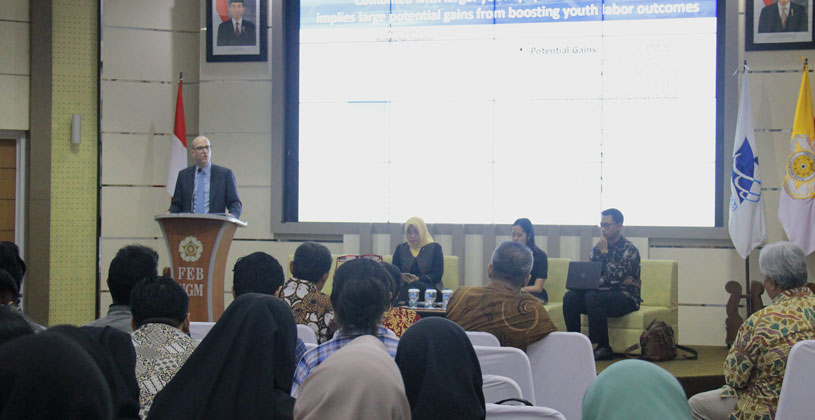Demographic Bonus: Threat or Opportunity?
- Details
- Written by Febyolla
- Category: News
- Hits: 26597

Population census data in 2018 shows that population that are in productive age (15-64 years old) reached 179.13 million people or around 67.6% of Indonesia’s total population. The huge number predicts Indonesia to enter new phase, known as demographic bonus. Demographic bonus is a condition in which the productive age population is more than the non-productive population. Demographic bonus can be a bonus if the younger generation are able to get decent education and facility to improve their self-quality. Hence, Indonesia strives to improve its human resource in order to develop future leaders so that the demographic bonus would be a bonus instead of a curse. This phenomenon was later raised and discussed in Discussion Forum themed “Work in Progress: Improving Youth Labor Market Outcomes in Emerging Market and Developing Economies” on Friday (1/3).
The event that was held at the eighth floor of Learning Center Building was a Discussion Forum and it was organized by Faculty of Economics and Business Universitas Gadjah Mada (FEB UGM) collaborated with International Monetary Fund, and Ikatan Sarjana Ekonomi Indonesia (ISEI). The Discussion Forum was filled by renowned economist. They are John C. Bluedorn Ph.D. as the representative of the IMF, Gumilang Aryo Sahadewo, S.E., M.A., Ph.D. as lecturer of FEB UGM, and Dr. Ninasapti Triaswati, S.E., M.Sc. as the representative of ISEI. The event which took place in the morning was guided by moderator Jesita Wida Ajani as Achieving Student of FEB UGM 2018.
The event was begun with a presentation delivered by John C. Bluedom. According to him, economic growth and development are closely related to role of the young generation. One third of the total productive age workers consist of young people aged 15-24 years. Moreover, it is predicted that the young generation in developing countries can increase real output by 5%. However, the young generation at the moment are faced with high level of inactivity. In fact, 20% of the young generation are unemployed, uneducated, and unskilled.
The discussion of the young workforce was further reviewed by Gumilang. According to him, unemployment amongst the younger generation is caused by several factors, such as skill mismatch, available jobs that are not accordance with educational background, as well as low demand for skill training. Data from International Labour Organization (ILO) states that at least 60% workers in Indonesia work in fields that are not accordance with their education. Furthermore, not all Indonesian have access to education, especially the middle to lower class people. As the result, the labor market in Indonesia is less competitive compared to other countries.
The problem in labor sector does not only end in that point. Nina explained that the urge of various digital startups as the result of Industrial Revolution 4.0 also posed a threat to the labor market. On the one hand, these digital startups ease almost all aspects of people’s life from the ease of obtaining complete and timely information to buying online goods. On the other hand, the advancement of technology causes gap in labor market, especially when a country is not supported by decent infrastructure. Thus, government intervention is needed so that the paradigm shift, from labour intensive to capital intensive, does not cause an increase in unemployment in Indonesia.
Source: Febyolla Putri Aninditya


